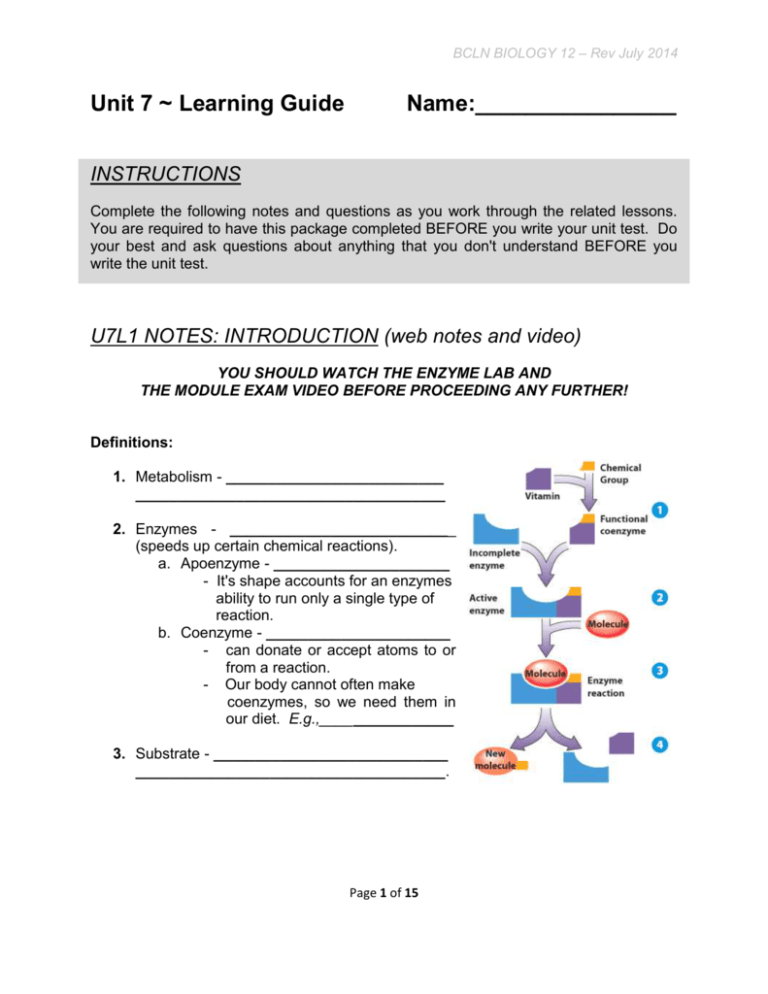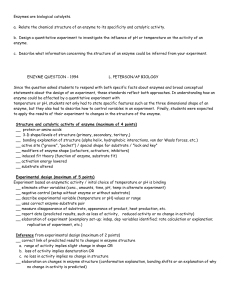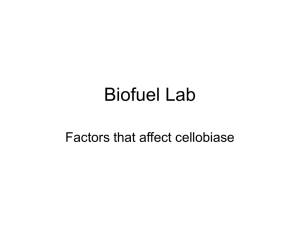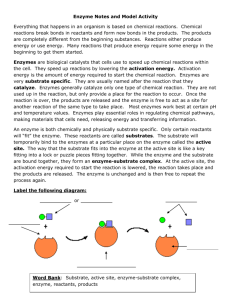BI12_LG_U07 - BC Learning Network
advertisement

BCLN BIOLOGY 12 – Rev July 2014 Unit 7 ~ Learning Guide Name:________________ INSTRUCTIONS Complete the following notes and questions as you work through the related lessons. You are required to have this package completed BEFORE you write your unit test. Do your best and ask questions about anything that you don't understand BEFORE you write the unit test. U7L1 NOTES: INTRODUCTION (web notes and video) YOU SHOULD WATCH THE ENZYME LAB AND THE MODULE EXAM VIDEO BEFORE PROCEEDING ANY FURTHER! Definitions: 1. Metabolism - __________________________ _____________________________________ 2. Enzymes - ___________________________ (speeds up certain chemical reactions). a. Apoenzyme - _____________________ - It's shape accounts for an enzymes ability to run only a single type of reaction. b. Coenzyme - ______________________ - can donate or accept atoms to or from a reaction. - Our body cannot often make coenzymes, so we need them in our diet. E.g.,________________ 3. Substrate - ____________________________ _____________________________________. Page 1 of 15 BCLN BIOLOGY 12 – Rev July 2014 4. Activation Energy - Many reactions will not occur unless _____________ is added to start the reaction off. Example: A piece of wood needs an input of energy to start it burning. This input of energy is called the ______________________________ or energy of activation. Thyroxin The _________________________, located in the neck, accumulates __________________ in order to produce ___________________________________ ________________________. Thyroxin is a _________________________ that is secreted into the ___________________ by cells of the thyroid. It attaches to a _____________________ ____________ on the surfaces of our body cells where it governs the __________________________ _________________________________, thus having an overall impact on __________________________ ___________________________________________ _______________________. Thyroxin does not have a target organ; it stimulates most of the cells of the body to metabolize at a faster rate. The number of respiratory enzymes increases, as does oxygen uptake. Thyroxin also helps _____________________________ _____________________________________________. Thyroglobulin is the storage form of __________________. Iodine is required for Thyroglobulin to be made. No iodine, the thyroid gland will increase activity as a mechanism to produce more thyroxin. Unfortunately ____________________ ____________________. Simple Goiter: A simple goiter occurs when __________________ _______________________________________________________ of the body through sufficient hormone production. The thyroid gland compensates by enlarging, which usually overcomes mild deficiencies of thyroid hormone. Page 2 of 15 BCLN BIOLOGY 12 – Rev July 2014 Exothalmic goiter: _____________________ is characterized by excessive production of thyroid hormone. ___________________________________ ___________________________________ are characterized by an enlarged thyroid gland and protrusion of the eyeballs. (Be sure you know where thyroxin is made, how it affects the cells in the body, and how it affects metabolism) U7L1 PRACTICE: INTRODUCTION 1. Create a web connecting the terms below. Please show how the terms are connected (5 marks). o Metabolism o Enzyme o Substrate o Coenzyme o Activation energy a. Example web for the terms: mitochondria, energy, vesicles, Golgi bodies, nucleus Page 3 of 15 BCLN BIOLOGY 12 – Rev July 2014 b. Now your turn for: metabolism, enzyme, substrate, apoenzyme, coenzyme and activation energy 2. Thyroxin is an important example of a hormone in our body: a. Where is thyroxin made? (1 mark) b. What is its function? (1 mark) c. What is the effect of too little thyroxin? (1 mark) d. What is the effect of too much thyroxin? (1 mark) Page 4 of 15 BCLN BIOLOGY 12 – Rev July 2014 U7L2 NOTES: ENZYMES (web notes and video) Lock and Key Theory of Enzyme Action A. In order for a reaction to occur, the reactants (substrates) must be brought ____________________________. B. The ______________________ bond to the __________________ on the enzyme, and are brought close together. Sometimes the active site changes shape to bring the substrates together. C. The reaction occurs and the ____________________ are released. The enzyme goes back to its normal tertiary configuration (shape). According to this analogy, an enzyme acts like a ________ by combining with a specific substrate and "_______________" the substrate for further activity of the cell. This is a useful analogy because the key (_________) must have the correct ______________ to fit the lock (substrate). After the lock has been opened (_______________________) the key (enzyme) is free and unchanged so that it may be ___________________________ in the same manner. The portion of the enzyme that is involved in the reaction is called the _____________________. YOU SHOULD WATCH THE ENZYME STRUCTURE VIDEO, THE LOCK AND KEY VIDEO, AND THE SUMMARY VIDEO BEFORE PROCEEDING ANY FURTHER! Page 5 of 15 BCLN BIOLOGY 12 – Rev July 2014 Metabolic Pathway Note: Metabolic Pathways are very complex and multi-stepped with intermediate products that are then use as the reactant for the next step. W = beginning substrate X, Y = intermediate products/reactants Z = final product Number = Enzymes Factors Affecting Enzyme Activity A. Heavy Metals: Such as Pb+2 (lead) or Hg+2 (mercury) can bond with parts of enzymes and cause them to change shape (_________________ them). This bonding is called ___________________________ _____________________. The enzyme is inactive _________ ____________________________ This is explained by a process in which the inhibitor fits into a place (site) on the enzyme, which is different from the active site. When this happens, the folding of the enzyme changes a little bit, and the _____________________________________ in a way, which makes it a less effective catalyst. The enzyme can no longer bond to its substrate so there is no chemical reaction. B. Competitive Inhibition: Some molecules are shaped like a substrate and compete with the ____________________ for the enzyme's active site. A competitive inhibitor fits into the enzyme's _______________________ but doesn't react with anything there. This prevents the correct _______________________________________________________. Example: Cyanide is an electron transport inhibitor Since some of the enzymes get bonded to the "wrong" substrate, the __________________ of "correct" production is reduced. Sometimes these molecules only bond temporarily with the _________________, but sometimes they bond permanently (for the life of the enzyme) rendering the enzyme useless. Page 6 of 15 BCLN BIOLOGY 12 – Rev July 2014 If too many important enzymes are inactivated, the organism may ____________. C. Temperature: ____________________________________________________ ________________________________________________________________ Warm temp to around 40oC speed up reactions High Temp – ________________ enzymes and cause reactions to stop If we increase the _____________ of the solution the enzyme is operating in, we will typically see an increase in the reaction rate until a point is reached at which the enzyme __________________________. This is a result of breaking hydrophobic bonds as the increase in temperature causes the enzyme's structure to "__________________" around. The enzymes active site changes shape so that it can no longer bond to its substrate and as a result there is no chemical reaction. D. pH: ____________________________________________________________ ________________________________________________________________ Any other pH affects tertiary structure (shape of the active site) of the enzyme and slows down reactions. Too much of a change ____________________ __ the enzyme so it can no longer bond to its substrate and stops the reaction. To the right are examples of various enzymes showing their optimum pH levels: Page 7 of 15 BCLN BIOLOGY 12 – Rev July 2014 E. Substrate Concentration: __________________________________________ ________________________________________________________________. If we do a series of experiments arranged so the concentration of the enzyme is always the same, but the substrate (reactant) concentration is increased from one experiment to the next, we find that in the _______________________ _______________________ the rate increases as we increase substrate concentration. However as the experiments involve higher and higher substrate concentrations, we find that we _____________________________________________. More substrate doesn't increase the rate any more. At this point, we say that the enzyme is _________________ (it can't handle any more). To increase the rate again, we'd need more ___________________. F. Enzyme Concentration - _______________________________________ _____________________________________________________________. What happens if we change the concentration of an enzyme? More catalyst means a faster ________________, so the reaction rate increases. (Reaction rate is basically "how much substrate reacts in a particular amount of time, usually a ________________). Page 8 of 15 BCLN BIOLOGY 12 – Rev July 2014 U7L2 PRACTICE: ENZYMES 1. Complete the following table by giving the name for the enzyme that acts on each substrate listed. (3 marks). Substrate Enzyme Maltose Peptides Nucleic Acids Neutral Lipids Acetylcholine Starch 2. Chemical reactions in cells occur at lower temperatures because enzymes ___________________ the activation energy for the reaction. (1 mark) 3. Label the diagram with the following terms: enzyme, substrates, co-enzyme, enzyme-substrate complex, product, and activation site. (6 marks) Page 9 of 15 BCLN BIOLOGY 12 – Rev July 2014 4. The ____________________________ on an enzyme is the region where the substrate fits with the proper geometry for a reaction to occur. This “fit” between the enzyme and substrate is called the ____________________________ model. (2 marks) 5. Explain the lock and key model of enzyme action. Why does denaturation of the enzyme prevent it from functioning properly? (2 marks) 6. Compare and contrast competitive versus non-competitive inhibition. (2 marks) 7. List two environmental factors that can change the shape of an enzyme. (2 marks) Page 10 of 15 BCLN BIOLOGY 12 – Rev July 2014 8. Label the vertical and horizontal axes in the following diagrams. (6 marks) a. b. c. PLEASE REMEMBER: YOU MUST PERFORM AND SUBMIT THE ENZYME LAB BEFORE THIS UNIT IS COMPLETE! REFER TO THE UNIT 7 DROP-DOWN MENU TO ACCESS THE LAB GUIDE AND LAB. ~ END OF BIOLOGY 12 UNIT 7 LEARNING GUIDE ~ Page 11 of 15 BCLN BIOLOGY 12 – Rev July 2014 UNIT 7 ANSWER KEY U7L1 PRACTICE: INTRODUCTION 1. Create a web connecting the terms below. Please show how the terms are connected (5 marks). o Metabolism o Enzyme o Substrate o Coenzyme o Activation energy Answers will vary. One possible example Page 12 of 15 BCLN BIOLOGY 12 – Rev July 2014 2. Thyroxin is an important example of a hormone in our body: a. Where is thyroxin made? (1 mark) = thyroid b. What is its function? (1 mark) = regulate oxygen consumption and therefore, overall rate of metabolism c. What is the effect of too little thyroxin? (1 mark) = hypothyroidism…slower metabolism, lethargic, weight gain, enlarged thyroid d. What is the effect of too much thyroxin? (1 mark) = hyperthyroidism…faster metabolism, "nervous energy", weight loss, bulging eyes, enlarged thyroid U7L2 PRACTICE: ENZYMES 1. Complete the following table by giving the name for the enzyme that acts on each substrate listed. (3 marks). Substrate Enzyme Maltose maltase Peptides peptidases Nucleic Acids nucleases Neutral Lipids lipases Acetylcholine acetylcholinesterase Starch amylases 2. Chemical reactions in cells occur at lower temperatures ___________________ the activation energy for the reaction. (1 mark) Page 13 of 15 because enzymes BCLN BIOLOGY 12 – Rev July 2014 3. Label the diagram with the following terms: enzyme, substrates, co-enzyme, enzyme-substrate complex, product, and activation site. (6 marks) activation co-enzyme substrates enzyme-substrate complex product site enzyme 4. The ____________________________ on an enzyme is the region where the substrate fits with the proper geometry for a reaction to occur. This “fit” between the enzyme and substrate is called the ____________________________ model. (2 marks) 5. Explain the lock and key model of enzyme action. Why does denaturation of the enzyme prevent it from functioning properly? (2 marks) = the three dimensional shape of the enzyme's activation site is complimentary and specific to the three dimensional shape(s) of its substrate(s) = when an enzyme is denatured its three-dimensional shape is altered, typically such that it no longer compliments its substrate(s) three-dimensional shape(s), and thus, it can no longer bind to the substrate(s) to lower the reaction's activation energy and speed up (catalyze) the reaction. 6. Compare and contrast competitive versus non-competitive inhibition. (2 marks) = competitive inhibition is when a substance, other than the substrate itself, competes with and binds to the active site of the substrate's enzyme, when the competitive inhibitor binds to the enzyme's active site the substrate can no longer do so and thus, the enzyme cannot effectively catalyze the reaction and the reaction rate slows down (common regulatory mechanism often involving a negative feedback loop) = non-competitive inhibition is when a substance, other than the substrate itself, binds to an alternate site (allosteric site as opposed to the active site) on the substrate's enzyme, when the non-competitive inhibitor binds to the enzyme's allosteric site it alters the enzyme's three dimensional structure including its active site such that the substrate can no longer bind to the enzyme and thus, the enzyme cannot effectively Page 14 of 15 BCLN BIOLOGY 12 – Rev July 2014 catalyze the reaction and the reaction rate slows down (another common regulatory mechanism often involving a negative feedback loop) 7. List two environmental factors that can change the shape of an enzyme. (2 marks) = change in pH (addition of either H+ or OH- ions to the solution surrounding the enzyme as it tends to interfere with hydrogen bonds that influence the enzyme's three dimensional shape) = increase in temperature (tend to disrupt bonds influencing the enzyme's three dimensional shape) 8. Label the vertical and horizontal axes in the following diagrams. (6 marks) Temperature °C Reaction Rate (variable units) b. Subtrate Concentration (variable units) c. Reaction Rate (variable units) Reaction Rate (variable units) a. pH Page 15 of 15








